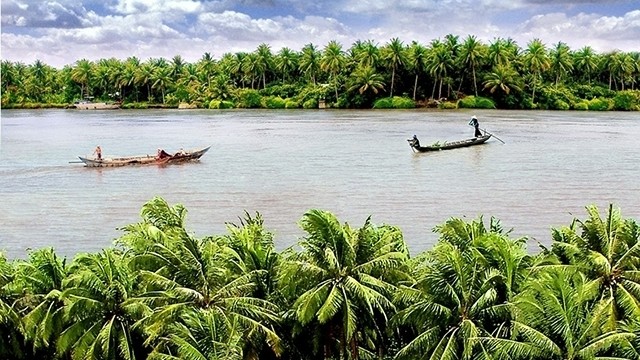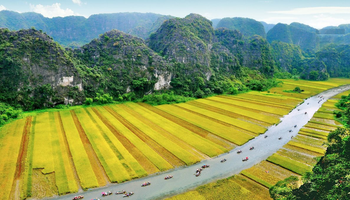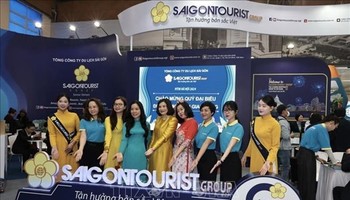Unique floating coconut market
Referring to the Mekong Delta province of Ben Tre is mentioning coconuts. The vast coconut forests and coconut gardens stretch to the skyline would overwhelm visitors as soon as they set foot across the Rach Mieu Bridge linking Tien Giang and Ben Tre provinces. However, what is more impressive is the large scenery of the floating coconut trading market on the banks of the Thom River.
Travelling on about 15 km from the centre of Ben Tre City along Highway No. 60 to the junction of Thom market, there is an iron bridge connecting the two districts of Mo Cay Bac and Mo Cay Nam on the Thom River. Walking up the middle of the bridge, visitors can zoom in on all four sides to feel more clearly a typical floating market in the Southwest region. The unique thing is that this floating market has only one product – coconut – and more precisely is all things related to coconuts and coconut production activities, such as coconut peeling, drying coconut cover or collecting coconut flesh. Looking down from the bridge, there are endless lines of ships carrying coconuts in and out of the granaries.
According to deputy director of the Tourism Information and Promotion Centre of Ben Tre Province, Vo Thanh Son, it is not clear when the coconut floating market came into being, but the Thom River is a circulating route between the Co Chien and Ham Luong Rivers via Mo Cay - Vam Thom Canal, which was dug in 1905. The river has a length of 15 km, which is an important waterway traffic section of the Tra Vinh - Vinh Long - Ben Tre passenger ships. Therefore, there are many villages producing coconut fibre on both sides of the Thom River in Thanh Thoi B, An Thanh, Tan Hoi and Da Phuoc Hoi communes of Mo Cay Nam district, as well as Khanh Thanh Tan in Mo Cay Bac district. If the whole Ben Tre province has more than 250 facilities producing coconut fibre, those along the Thom River alone have made up about 200 establishments, attracting thousands of local workers. It is worth mentioning that in addition to light works here, women also encroach in hard work, requiring good health and endurance for men only, like coconut peeling.
Coconut peeling on the banks of the Thom River takes place around the clock, even early in the morning to catch the morning market. At a coconut basket, Tuyet Nhung stands between the above-the-head coconut heaps. In front of her, a lot of dried and shelled coconuts mix with tall stack of split coconut husks waiting for making coir. It was very difficult to climb down near Nhung without falling down, to observe her skilful hands when peeling each coconut. Coconut peeler is a thick, pointed and hard iron knife that is erected vertically, called a “lying tip”. The coconuts will be pitched down on the knife and Nhung's healthy hands will peel its cover off. It took four attempts peeling to get a coconut skull, but for an hour, Nhung can peel about 200 coconuts for a salary of VND40,000.
On average, a woman like Nhung can peel about 1,000 coconuts a day and receives VND200,000. However, it is not easy to be able to master this job. Nhung has nearly 20 years in the work and she suffered from many accidents from breaking her fingers to her knives. Each specialised knife to separate coconuts costs about VND400,000-500,000 and in that case it is broken, it seems that Nhung has lost two days of working.
Towards a specific coconut brand
Along with the tourism development of the Mekong Delta in particular and the country in general, Ben Tre has gradually built a tourism brand of "Eco-river Tourism in the Coconut Land" with typical local characteristics to boost it sustainable tourism.
According to Le Van Luong, head of the Tourism Information and Promotion Centre of Ben Tre Province, tourism is diversified, but in this Southwestern region, garden and river ecotourism is pretty much duplicated as many locales are similar with their natural river potentials. To make a difference, Ben Tre has aimed to build a tourism brand dedicated to both local rivers and its coconuts, which is different from river tourism in other provinces in the region, such as Cai Be floating market in Tien Giang, Cai Rang floating market in Can Tho, lotus floating region in Dong Thap, or floating gardens in An Binh isle in Vinh Long. It is a separate direction with unique characteristics to attract domestic and foreign tourists to Ben Tre which is different from other Mekong Delta provinces. That is also the reason for the Thom river coconut floating market to become an important part in developing coconut river eco-tourism.
With more than 70,000 ha of coconuts, Ben Tre occupies half of the nation’s total coconut area. Currently, in addition to tours operated by travel companies, the Ben Tre Tourism Information and Promotion Centre has also run five tours, including Chau Thanh, Ben Tre City, Giong Trom - Ba Tri, Mo Cay Bac - Cho Lach and Mo Cay Nam - Thanh Phu. Particularly for Mo Cay Nam - Thanh Phu tour, visitors can take a boat on the Thom river - Mo Cay Nam, while boating and visiting the coconut floating market and arriving at villages processing coconut and making coconut candies and handicrafts from coconut wood, as well as visiting many other historical sites and the Thanh Phu mangrove forest eco-tourism area.
According to the leaders of Ben Tre culture, sports and tourism sector and representatives from travel agencies, there must be consensus and companionship in sharing, promoting and contributing to the development of the common coconut river eco-tourism brand of Ben Tre. For example, it is crucial for the cooperation of all branches in investment in embellishing and constructing tourist attractions and nature reserves, as well as investing in restoration of historical and cultural relics and preserving and promoting the value of traditional trade and craft villages.
It is also necessary to connect tours and routes between destinations in the province with other tours and destinations in the region. All will contribute to enriching tourism products, helping Ben Tre create a coconut river eco-tourism path.
In the last three years, the province has received a relatively large number of tourists compared to other localities in the region. In 2016, it welcomed nearly 1.2 million visitors but in 2018 the figure was nearly 1.6 million, bringing the revenue from tourists from VND860 billion in 2016 to over VND1 trillion in 2017 and more than VND1.3 trillion in 2018.
Leaving the Thom River with red tile roofs hidden in the green and fruitful coconut trees, the industrious, naive, liberal image of the sincere and affectionate people in the land of coconut is still deep in the memory of visitors. It is with their hardwork and their love of their homeland that has created an attraction to tourists to come to know more about and love close and dear Ben Tre.
















